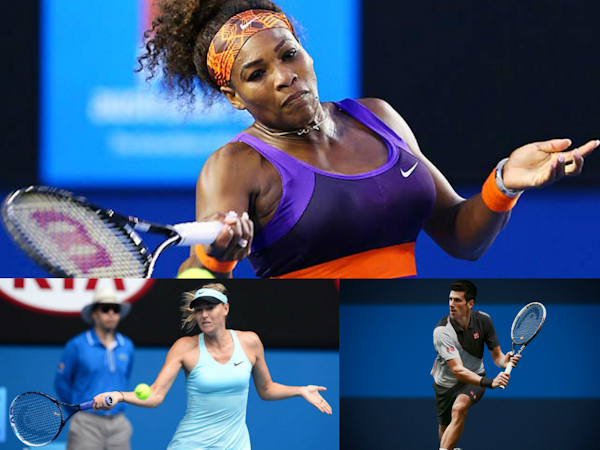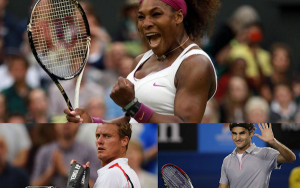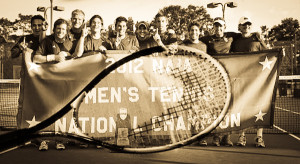Photo by: Will Gentry
Grand Slam season is underway in the world of professional tennis.
The Australian Open – the first of the four major tournaments – kicked off Jan. 13 in Melbourne, Australia and ends on Sunday, Jan.26.
The four Grand Slam tournaments, or Majors, are the four most important annual tennis events. The Australian Open is played in mid-January, the French Open between May and June, Wimbledon in June and July, and the U.S. Open in August and September. Each tournament is played over a span of two weeks and contributes points and rankings to the highest achievement in professional tennis: the Grand Slam – winning all four majors.
The two biggest stories from the 2014 Australian Open have been the extreme temperatures – with heat topping 111 degrees – and Saturday’s defeat of No. 1-ranked and tournament favorite Serena Williams.
“Because of the court surface, heat radiates and there can be on-court temperatures of up to 150 degrees,” sophomore and tennis fan Jonathan Johnson said. “That creates many variables and changes factors when it comes to performance on the court, because the heat has been known to loosen racket strings, create the ball to bounce lower and a little bit faster – speeding up the pace of the game but slowing down the player due to exhaustion.”
In the Australian Open, women play the best of three sets. In the case of extreme heat, much like this year, between the second and third set women are allowed a single 10-minute break. Maria Sharapova used her break against Italian Karin Knapp in the second round of the tournament. Men, however, do not have the opportunity to ask for a break, even though they play the best of five sets. The arena in Melbourne has a retractable roof that the umpire can choose to open or close, but the umpires have not ruled to close it yet.
“I do not think it’s fair,” Johnson said. “Men have to play the best of five sets while the women play three, and that is just as physical if not more. It is very extreme and there should be an opportunity for a break for the men as well.”
The 2014 Australian Open started with a bang when Venus Williams lost in the first round to No. 22-seeded Ekaterina Makarova. Williams, who was competing in her 14th Australian Open and was the second-oldest player at age 33, suffers from Sjogren’s syndrome, which causes victims to suffer from fatigue and other exhaustion-related symptoms.
“It was disappointing to see Venus lose in the first round,” Johnson said. “She started off strong in the first set, but was weaker in the second. She just fell flat in the third set. It’s understandable with her disease. She is constantly exhausted, so you have to get her some credit.”
Serena Williams’ loss to No. 18-ranked Ana Ivanovic was the most surprising and heart-breaking loss so far for many tennis fans. Ivanovic’s win set a social media record, with 123,000 tweets being sent during the course of the match, crushing the previous Australian Open record of 1,906 retweets.
According to The New York Times, Serena Williams was very “diplomatic” in her loss, telling The Times, “I don’t want to blame anything. I feel like Ana deserves all the credit. It’s not like I gave her the match. I almost didn’t play.”
In previous years, Serena’s attitude and high-profile handling of losses has been pointed to as one of the biggest turn-offs of professional tennis.
“I feel like her attitude is a lot better than previous tournaments,” Johnson said. “She’s realized she is human and she will make mistakes, but I don’t think that consumes her and her attitude on the court. The way she rocks back and forth on the court on the base line and throws fist pumps into the air is very intimidating, especially for new and lower-seeded players.”
No. 3 Maria Sharapova’s chances at an Australian Open win were crushed Sunday night with an upset to No. 20 Dominika Cibulkova in the fourth round of the tournament. Sharapova’s loss came less than 24 hours after Serena’s fall from the top.
“Younger players are going in and not being worried about playing Sharapova because she has been out and hasn’t been playing her best,” Johnson said. “Younger players – like Alize Cornet who took her to three sets in the second round – are taking advantage of that, acting cockier and abusing her weak points.”
Chasing his fifth Australian Open championship, Roger Federer must fight through three of the biggest names in tennis – Jo-Wilfred Tsonga, Andy Murray and Rafael Nadal. Federer’s biggest opponent would have been Novak Djokovic, who was battling for his fourth consecutive Australian Open title, but Djokovic fell to Stanislas Wawrinka in five sets.
“This is clearly a tough draw I have,” Federer said to the Australian Open’s official website. “But important for me now is to not go crazy about who I play.”
The Australian Open has made many improvements to this year’s tournament in order to compete with the greater two of the Majors, Wimbledon and the U.S. Open. Improvements in graphics, which include more interactive features on-screen and fresher colors along with the extractable roof on top of the stadium, are just a few of the new additions to the youngest of the four Majors.
“It’s exciting to be able to watch the Australian Open,” Johnson said. “It’s the first Grand Slam of the tennis season. For tennis players, it’s kind of like we have four Super Bowls or World Series and this is the first one. When you think of the Grand Slams, you think of Wimbledon and the U.S. Open. The Australian Open has always been on the lesser end of the four and with its new improvements in its features, it is really starting to step things up.”














Be First to Comment